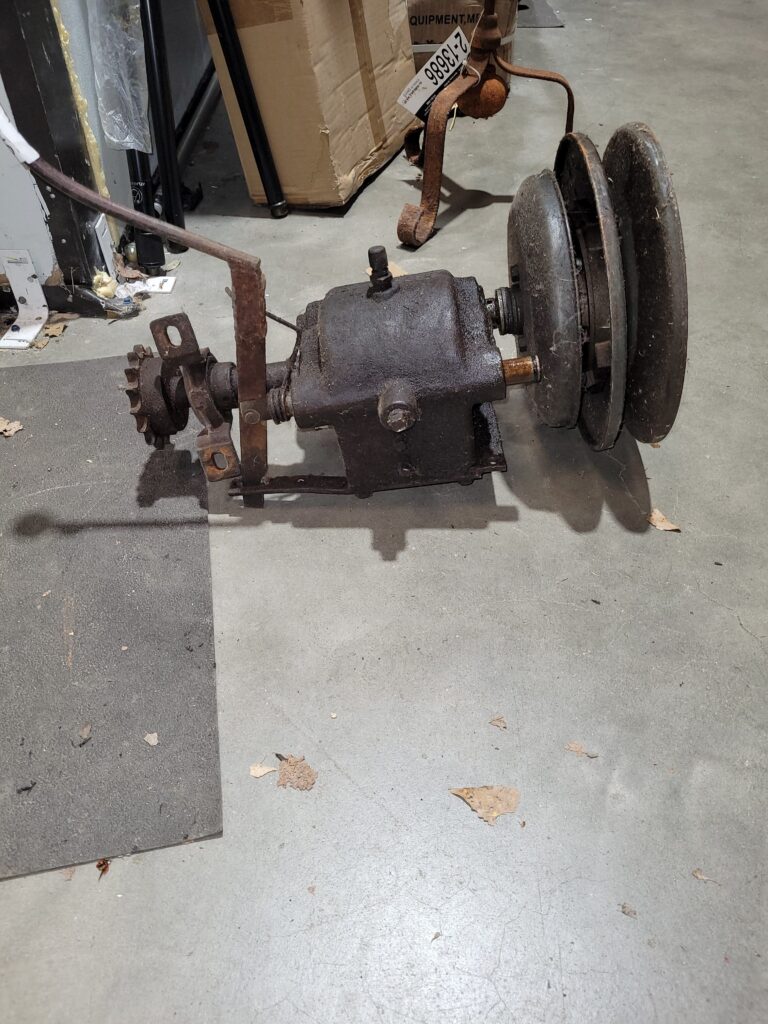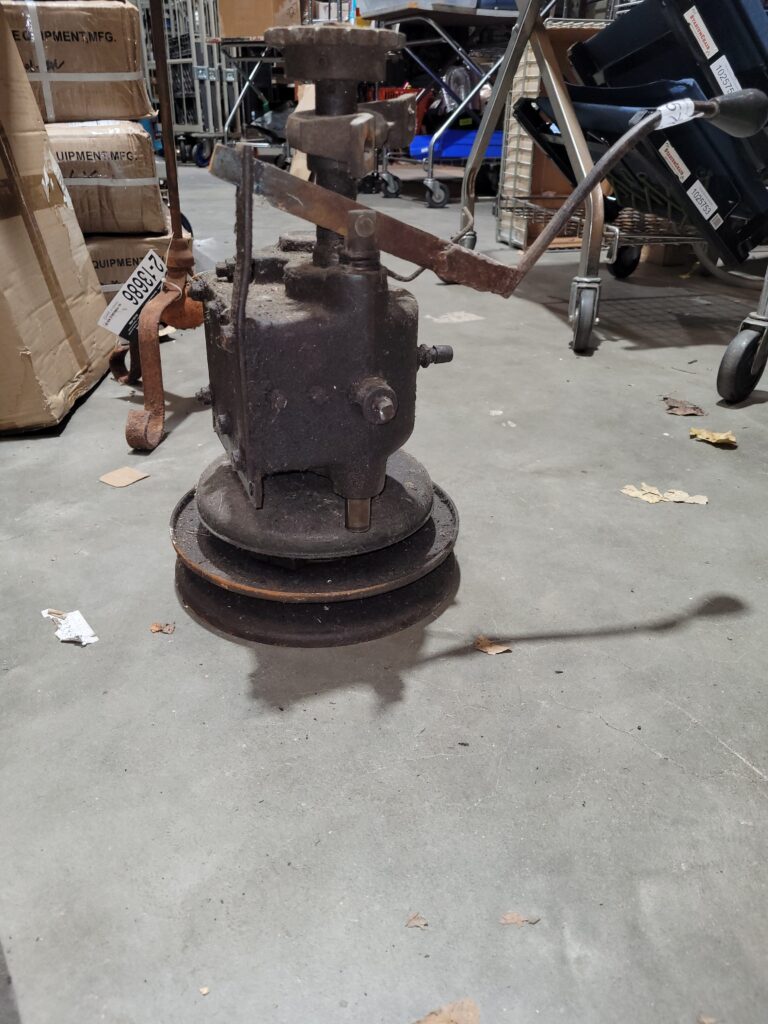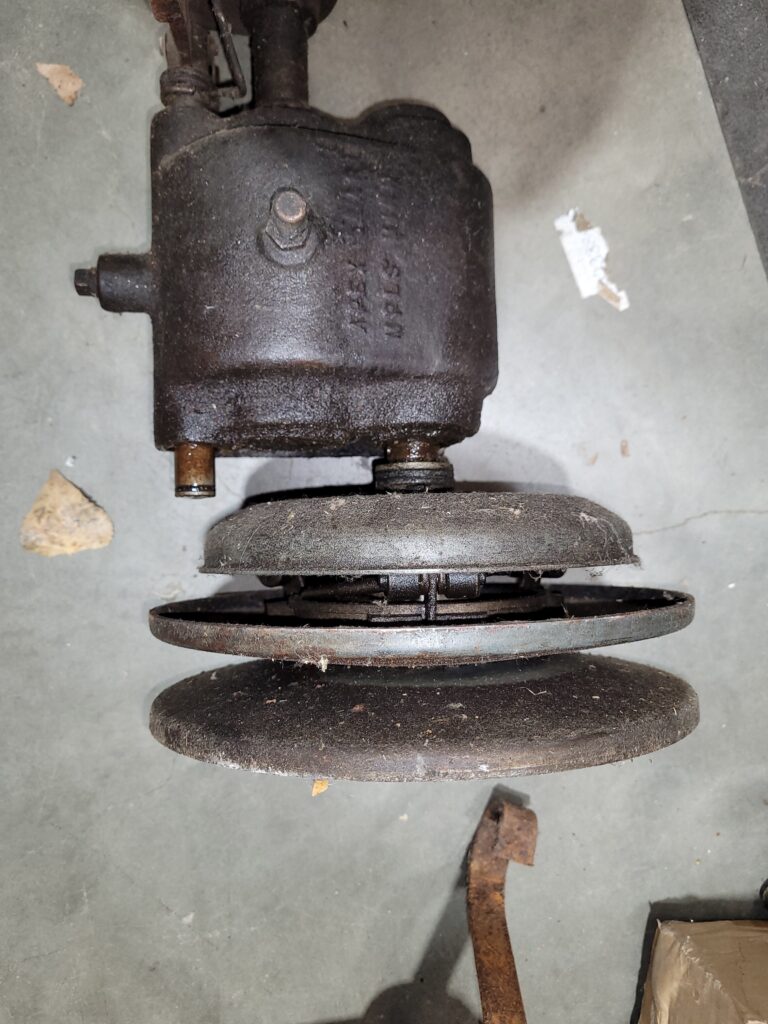Longtime reader and good friend Terrapod recently came across something that neither one of us can positively identify so he asked me to put it up and see if anyone else knows what it is and what it is for.
It appears to be bigger than I thought at first glance and in my opinion I think it is some kind of belt driven Two Speed transmission of some kind. A High-Low kind of thing.
The variable speed pully set up is connected to a clutch he says and it obviously drives a chain for something.
I do have to give him credit for taking way better pictures than I do so have at it and we shall see what you guys can come up with.



It looks plenty heavy and having a cast iron case tells me it’s fairly old.
Whaddya got?

Looks like something from a combine or some kind of harvester. The large sheave seems to be spring loaded so the tighter the belt, the deeper into the sheave the belt would be thus changing the input speed. It might be an in and out gearbox to disconnect the drive.
Some kind of continuously variable transmission?
That’s it, from a tractor or old farm rig. Early CVT…
The clutch looks centrifugal, my guess is similar to Paul V, but I will hazard to say this could be for a PTO
That is a pretty good guess. I was able to engage and disengage something on the gearbox moving the lever. Hefting it seems to be about 30 lbs. May very well be part of farm machinery. What was intriguing is that it seems fully functional and very little rust. Well oiled, smooth action. May attach a drill to the gear and see what it does. Will be surprised if it sells for more than 10 bucks at the auction.
It’s a garage space saver. It saves a corner in the garage for something useful. Can also be used as a wife-nag initiator. I used mine to throw my back out, worked perfectly.
Looks like a hydrostatic drive to me.
DEFINITELY a CVT. I had one on my Honda Elite 150 scooter, it had the centrifugal clutch that engaged/disengaged the drive belt. It was automatic, this one appears to b manually adjustable.
Here’s a good explanation of how they work:
https://www.youtube.com/watch?v=9cKbzUgFdS0
I got at least 35K out of each belt.
What Paul V said. More than likely off a combine or other farm machinery.
The chain drive would be run by the engine. At a set engine RPM you can adjust the output speed via the belt. The opposing curved plates move in and out and this changes the “pulley” size and changes the belt speed.
Maybe runs the thresher drum. Dunno.
Copy down the cast letters on the housing and put them into a search engine. Might give you the machine type or even model.
Did that, the search for Apex Gear Minneapolis MN did not produce any direct links. May have gone out of business a very long time ago. There are similar sounding names but they appear to produce modern machined aluminum parts.
After reading the comments, am leaning towards farm machine with the gear end being motor driven, the lever simply engaging/disengaging the drive to the sheave, and a centrifugal type clutch that then drives a belt of some sort on the theory that the faster the engine turns, the faster the belt moves as the two plates get closer together and push belt outwards. If I get a chance am going to see if I can make the gear end turn with a drill and play with it. Almost a crime for whatever it is to end up in scrap. Hope someone buys it. We have a lot of farms in this area, someone might see value in it.
Thanks Phil and gang for chiming in.
I’m seeing casted into the last picture “APEX GEAR MPLS MINN” which probably is the CVT version of this:
https://www.ebay.com/itm/283970331546
I’m guessing lawn mower because hitting ice chunks would be bad for the belt and nlowers use shear pins for that reason.
Thingamajig, yep that’s it
The shaft on the sprocket looks bigger so I would think it is the output shaft turn the shaft and count how many revolutions to find the gear ratio.
When I was a kid, there was a couple of saw mills in my little town. They were open sided with so you could see all the operations. This looks like the mechanism that has used to advance and return the log for each cut. The cut for a ten foot log was thirty-forty seconds depending on the log diameter. The return was quick. If that’s the case, there was a reversing mechanism that is missing. Operation was controlled by two arms like the one seen.
I’m going with a manure spreader. You need to continually adjust the output to get an even spread.
Looks like an old variable speed control for a lathe. Constant input chain drive variable out speed control from the cone drive.
Our John Deere forage wagons used something similar to this.
When the PTO was engaged the beaters and cross chain would start up. Then you pulled on a lever that varied the tension on on a CVT belt. As you increased the tension, the belt would change the gear ratio of the bed chain. This was so you wouldn’t overload the unloader section of the wagon. While this unit isn’t the same as our wagons, it might be a earlier version of a different brand.
Another possibility is it is the drivetrain for an old powersports vehicle. My father’s old Snow Fox had a unit similar to this. The gearbox was forward and reverse on that.
It is definitely a variable speed gearbox. The chain gear is the output, and the pulley is the driven sheave of a CVT. Typically, the driven pulley is closed at the bottom and spreads as the belt is pulled in – either mechanically or by a CVT drive clutch.
Leigh
Whitehall, NY
Could be that sort of thing has lots of applications
Maybe a african engineered drive for a horse walker carousel.
Might be from a Cushman scooter, hi/lo gearbox.
Well… here’s my 2cents worth…
My grandfather, then my dad owned a machine shop in Detroit. To me it looks like the the belt drive for an OLD lathe. Before electricity became abundant the lathes were driven by belts from a central shaft that was steam driven. My dad’s shop still had a few pre WW2 machines that had a small electric motor jimmy-rigged to where they used to be hooked to the drive belts.
Although., I’m also fairly certain that this type of “accessory” was useful across a wide range of products and types of work. But that was my first thought when I saw the pictures.